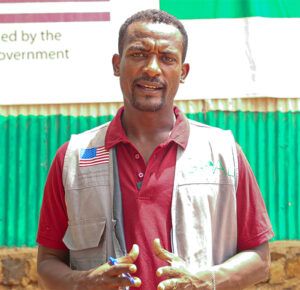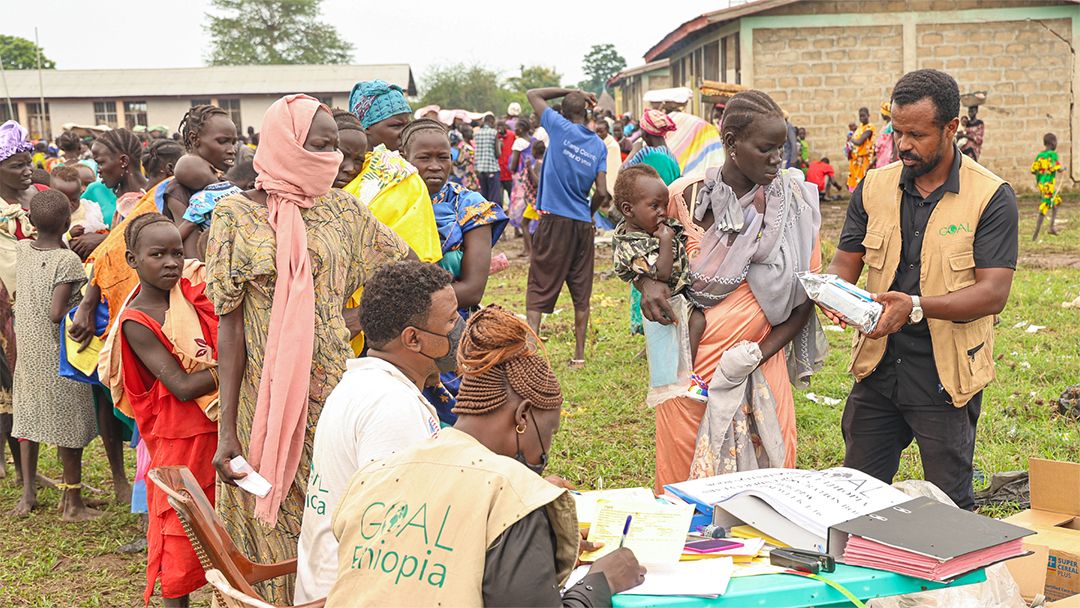 Blogs
Blogs
June 20, 2025 • 4 min read
Kalkidan Yishak has worked for GOAL since 2021. He reports from Ethiopia, where GOAL teams are responding to the needs of refugees fleeing the ongoing Sudanese conflict.
When I was deployed to South Sudan’s border with Sudan two years ago, the humanitarian crisis I witnessed defied description. Thousands of people, including the elderly, people with disabilities, pregnant mothers and children, were fleeing the outbreak of violence in Sudan. Many had walked for days, carrying only the clothes on their backs, desperately clinging to their loved ones. Thankfully, GOAL teams were there to greet them, working tirelessly to provide lifesaving food, water, medical care and shelter.
Fast forward to a month ago: I found myself at the Ethiopia-South Sudan border, reporting on yet another wave of displacement. This time, it was South Sudanese fleeing to Ethiopia due to escalating tensions. The contrast between these two experiences is striking. Two years ago, the crisis captured significant media attention, and funding partners were actively engaged in supporting the refugees. Today, the story is different.
Over 15,000 newly displaced South Sudanese have sought refuge in a small school and makeshift tents. The rainy season has transformed the school into a muddy swamp. Refugees rush toward any vehicle, regardless of its purpose, clinging to the hope that help has arrived. In the midst of this chaos, GOAL teams are doing their utmost to support the most vulnerable amidst dwindling resources.
“The need is overwhelming”

Alemayehu Reta, GOAL’s Refugee Programme Manager in Ethiopia
GOALies work tirelessly to support refugees in various ways. Some focus on assessing the physical condition of children, measuring their nutritional status to identify levels of malnutrition. Others distribute Plumpy’nut and other nutrient-packed foods designed to aid in the rapid recovery from malnutrition.
“This transit camp has only been operational for a couple of months. The need is overwhelming, and the school is packed beyond capacity, but as humanitarians, we are committed to helping with the limited resources we have.” Alemayehu Reta, GOAL’s Refugee Programme Manager, told me on a recent visit.
Numbers tell the story
Since April 2023, renewed conflict in South Sudan and Sudan has triggered a fresh wave of displacement. By August 2024, over 60,000 people, primarily from South Sudan, had crossed into Ethiopia through the Gambella and Benishangul-Gumuz regions. UNHCR also reports that approximately 70,000 Sudanese refugees fled to Ethiopia, with many in precarious transit camps. Ethiopia now hosts nearly 1 million refugees, with South Sudanese the largest group.
Shrinking Aid, Expanding Needs
As conflicts rage globally, more and more civilians are being forcibly displaced. Today, over 122 million people have been forced from their homes. That’s up 2 million on last year. Sudan has overtaken Syria as the largest single crisis, with over 14 million people displaced, surpassing the 13.5 million displaced by civil war in Syria. Despite this worrying trend, international humanitarian funding for refugees has dropped to levels last seen in 2015, even though needs have more than doubled.
The UNHCR urgently requires US$434.5 million this year to continue delivering lifesaving projects in Ethiopia. Alarmingly, only 20 per cent of this target has been met.
Despite the extent of the crisis, the exodus from Sudan and South Sudan into Ethiopia and other neighbouring countries remains largely unreported. While international solidarity and funding has remained stable for the prolonged crisis in Ukraine, vulnerable communities in the Horn of Africa are suffering due to dwindling aid. Refugees seeking safe haven are forced to endure life in crowded camps, risking the outbreak of deadly diseases such as cholera.

What must change
Restoring donor investment is critical to addressing the escalating humanitarian needs in countries like Ethiopia. It is imperative to reinstate funding to at least 2015 levels, aligning with urgent appeals such as Ethiopia’s $434 million target. This commitment would bridge funding gaps and enable the provision of life-saving assistance to vulnerable populations.
Equally important is the role of the media in drawing global attention to these crises. Sustained and in-depth coverage is needed to transcend the fleeting nature of episodic headlines, ensuring that the international community remains informed and mobilized to act.
Finally, ensuring the safety and dignity of refugees requires a comprehensive approach to protection and inclusion. Refugees must be safeguarded at transit points and afforded access to work, education, and a dignified standard of living. These measures are crucial for fostering resilience and enabling displaced individuals to rebuild their lives.

Kalkidan lives with his wife and two sons in Ethiopia
